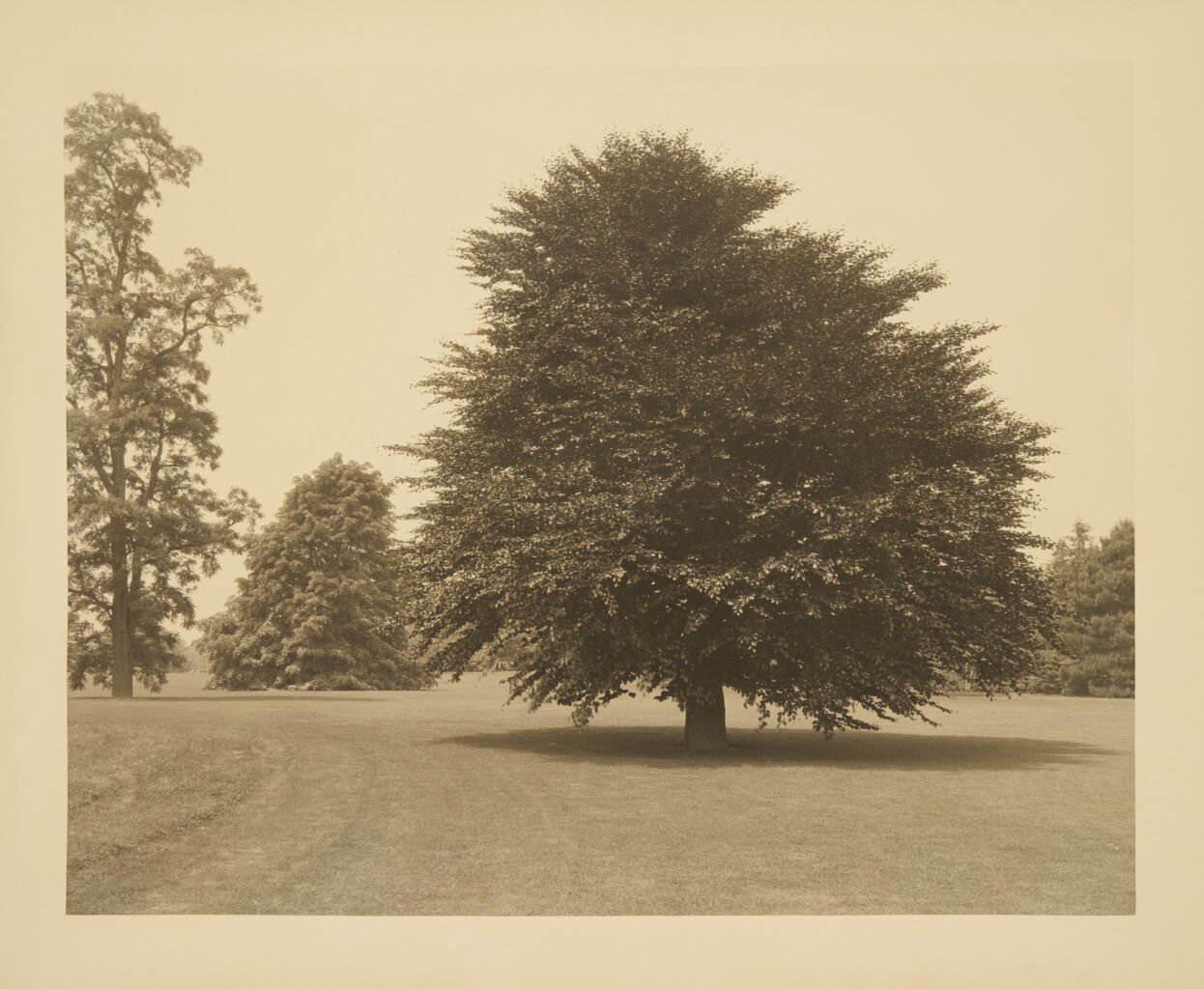Photo of the original beech tree on the West Lawn. Mattie Edwards Hewitt, c. 1922.
The Olmsted Brothers firm arrived at Planting Fields in 1918, sparking a change in the landscape design direction. Owner William Robertson Coe hired the Olmsteds as the result of two traumatic events: first, the original landscape architect and horticultural expert A. Robeson Sargent passed away unexpectedly at the age of 40 in March 1918; then, two weeks later on March 27th, a fire destroyed the Coe residence at Planting Fields. With the Olmsted Brothers firm came James Frederick Dawson, project leader and primary contact with Coe during the landscape’s progression. Dawson started as an apprentice in 1896 before becoming the first associate partner of the Olmsted Brothers landscape firm. He grew up in a horticulturist environment as his father was Jackson Thornton Dawson, superintendent of the Arnold Arboretum of Harvard University.
The first task the Olmsted Brothers accomplished at Planting Fields was securing a surveyor. The surveyor’s job was to collect drawings and observations of the existing landscape in order to build a base drawing of the entire property. Titled the “Lewis Survey” after the engineer who conducted it, the results captured the landscape work completed prior to the Olmsted Brothers’ arrival. Specifically, tree and shrub plantings, removals and transplants were annotated in field sheets. The survey was a clear starting point for the firm’s work on the estate.
The Olmsted Brothers brought new compositions, features and areas to the property, including the Carshalton Gate, Heather Garden and spatial organization of the East and West lawns. In addition, the landscaping around Coe Hall was designed to feature an entry court, Surprise Pool and the Camellia House. The areas that existed, but were modified by the Olmsted Brothers, include the Vista Walk and plantings in the Azalea Paths, Italian Garden and entry drive. The ultimate goal of the Olmsted Brothers’ design was to seamlessly blend the house and landscape. Anyone familiar with the property would recognize these areas as core features to Planting Fields topography.
The Olmsted Brothers firm carried on the landscape architecture principles established by their father, Frederick Law Olmsted Sr., who focused on creating special retreats, “places for both active and passive recreation; green and open spaces offering relief and refreshment from the pressures and tensions of everyday life.”[1] This outlook and emphasis on designing outdoor spaces to be enjoyed and experienced in multiple, beneficial ways can be seen today in his sons’ work at Planting Fields. In a 2019 study of the Planting Fields landscape, the preservation firm Heritage Landscapes identified four types of recreation common at the property:
- Recreative: to recreate oneself through exposure to nature, or the human manipulated nature of parks, relaxing, strolling, or casual walking, sitting, bird watching, sighting wildlife
- Gregarious: to enjoy being with others in a group, social recreation, the basis of democratic openness of park landscape to all people
- Exertive: basically, to work up a sweat through exercise, walking, jogging, yoga on the lawn, and so forth, which is most often self-directed not based on facilities
- Educational: an informative landscape, which at Planting Fields could be accessed through arboretum labels, programs, signage, various forms of interpretation and the like[2]
Although there were multiple landscape architects who worked at Planting Fields, the Olmsted Brothers firm had the longest lasting contribution. Their final work on the property was completed in 1929. Ninety-two years later the firm’s design has become skewed and muted. Restoring the property is imperative to manifest not only the original beauty of the space, but the mental serenity too. Through a series of projects, Planting Fields is working to recapture the historical significance and importance of the property’s landscape design.
by Kristy Pavlick
Edited and Finalized April 30, 2021
[1] https://www.emeraldnecklace.org/park-overview/frederick-law%E2%80%88olmsted/
[2] Heritage Landscapes, LLC, Preservation Landscape Architects & Planners, Planting Fields Cultural Landscape Report, September 2019 for Planting Fields Foundation in Collaboration with Planting Fields Arboretum State Historic Park, p. 312.

